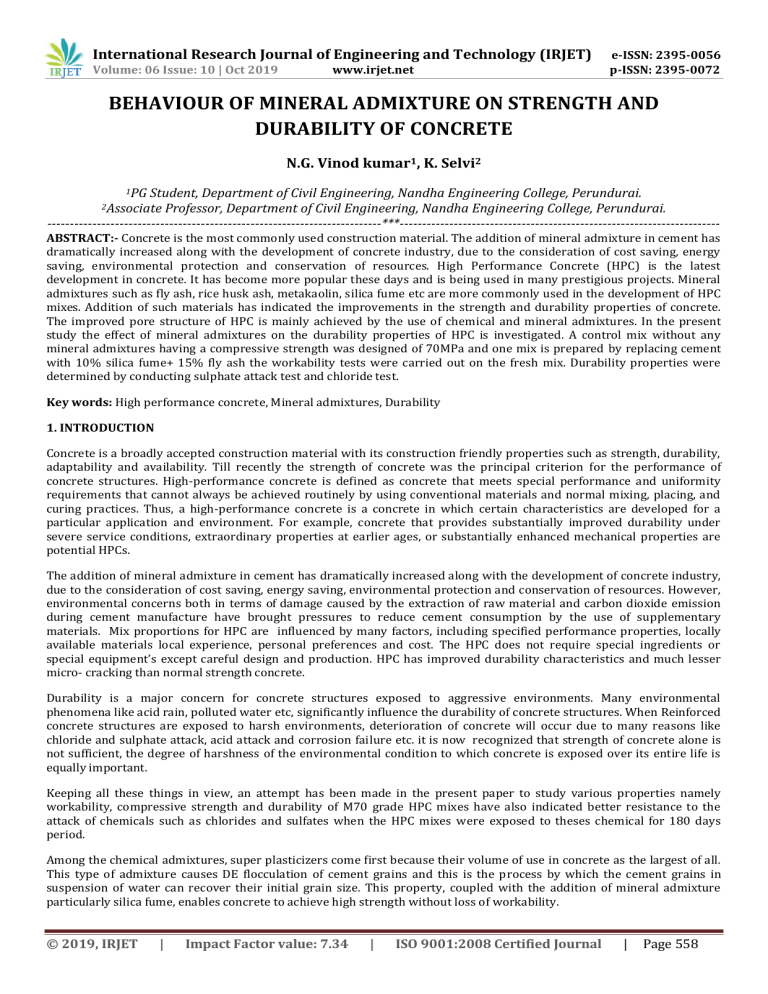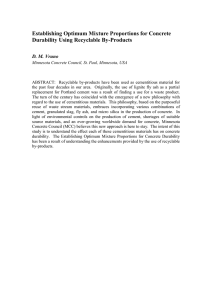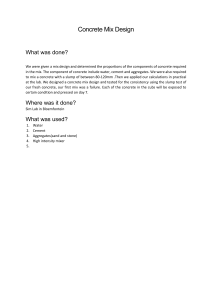IRJET-Behaviour of Mineral Admixture on Strength and Durability of Concrete
advertisement

International Research Journal of Engineering and Technology (IRJET) Volume: 06 Issue: 10 | Oct 2019 www.irjet.net e-ISSN: 2395-0056 p-ISSN: 2395-0072 BEHAVIOUR OF MINERAL ADMIXTURE ON STRENGTH AND DURABILITY OF CONCRETE N.G. Vinod kumar1, K. Selvi2 1PG Student, Department of Civil Engineering, Nandha Engineering College, Perundurai. Professor, Department of Civil Engineering, Nandha Engineering College, Perundurai. --------------------------------------------------------------------------***----------------------------------------------------------------------2Associate ABSTRACT:- Concrete is the most commonly used construction material. The addition of mineral admixture in cement has dramatically increased along with the development of concrete industry, due to the consideration of cost saving, energy saving, environmental protection and conservation of resources. High Performance Concrete (HPC) is the latest development in concrete. It has become more popular these days and is being used in many prestigious projects. Mineral admixtures such as fly ash, rice husk ash, metakaolin, silica fume etc are more commonly used in the development of HPC mixes. Addition of such materials has indicated the improvements in the strength and durability properties of concrete. The improved pore structure of HPC is mainly achieved by the use of chemical and mineral admixtures. In the present study the effect of mineral admixtures on the durability properties of HPC is investigated. A control mix without any mineral admixtures having a compressive strength was designed of 70MPa and one mix is prepared by replacing cement with 10% silica fume+ 15% fly ash the workability tests were carried out on the fresh mix. Durability properties were determined by conducting sulphate attack test and chloride test. Key words: High performance concrete, Mineral admixtures, Durability 1. INTRODUCTION Concrete is a broadly accepted construction material with its construction friendly properties such as strength, durability, adaptability and availability. Till recently the strength of concrete was the principal criterion for the performance of concrete structures. High-performance concrete is defined as concrete that meets special performance and uniformity requirements that cannot always be achieved routinely by using conventional materials and normal mixing, placing, and curing practices. Thus, a high-performance concrete is a concrete in which certain characteristics are developed for a particular application and environment. For example, concrete that provides substantially improved durability under severe service conditions, extraordinary properties at earlier ages, or substantially enhanced mechanical properties are potential HPCs. The addition of mineral admixture in cement has dramatically increased along with the development of concrete industry, due to the consideration of cost saving, energy saving, environmental protection and conservation of resources. However, environmental concerns both in terms of damage caused by the extraction of raw material and carbon dioxide emission during cement manufacture have brought pressures to reduce cement consumption by the use of supplementary materials. Mix proportions for HPC are influenced by many factors, including specified performance properties, locally available materials local experience, personal preferences and cost. The HPC does not require special ingredients or special equipment’s except careful design and production. HPC has improved durability characteristics and much lesser micro- cracking than normal strength concrete. Durability is a major concern for concrete structures exposed to aggressive environments. Many environmental phenomena like acid rain, polluted water etc, significantly influence the durability of concrete structures. When Reinforced concrete structures are exposed to harsh environments, deterioration of concrete will occur due to many reasons like chloride and sulphate attack, acid attack and corrosion failure etc. it is now recognized that strength of concrete alone is not sufficient, the degree of harshness of the environmental condition to which concrete is exposed over its entire life is equally important. Keeping all these things in view, an attempt has been made in the present paper to study various properties namely workability, compressive strength and durability of M70 grade HPC mixes have also indicated better resistance to the attack of chemicals such as chlorides and sulfates when the HPC mixes were exposed to theses chemical for 180 days period. Among the chemical admixtures, super plasticizers come first because their volume of use in concrete as the largest of all. This type of admixture causes DE flocculation of cement grains and this is the process by which the cement grains in suspension of water can recover their initial grain size. This property, coupled with the addition of mineral admixture particularly silica fume, enables concrete to achieve high strength without loss of workability. © 2019, IRJET | Impact Factor value: 7.34 | ISO 9001:2008 Certified Journal | Page 558 International Research Journal of Engineering and Technology (IRJET) Volume: 06 Issue: 10 | Oct 2019 www.irjet.net e-ISSN: 2395-0056 p-ISSN: 2395-0072 2. EXPERIMENTALINVERTIGATION Properties of Material Cement Fine aggregate Coarse aggregate Water Chemical Admixtures Mineral Admixtures Cement Physical and chemical characteristics of cement play a vital role in developing strength and controlling rheology of fresh concrete. Fineness affects water requirements for consistency. The cement selected to be used in HPC should contain as little C3A as possible because the lower amount of C3A, the easier to control the rheology and lesser the problems of cement-super plasticizer compatibility. From strength point of view, cement should be finely ground and contain a fair amount of C3S. Fine aggregate Both river sand and crushed stones may be used. Coarser sand may be preferred as finer sand increases the water demand of concrete and very fine may not be essential in HPC as it usually has larger content of fine particles in the form of cement and mineral admixtures such as silica fume, fly ash etc. The sand particles should also pack to give minimum void ratio as higher void content leads to requirement of more mixing water. Coarse aggregate The coarse aggregate is the strongest and last porous component of concrete. Coarse aggregate in cement concrete contributes to the heterogeneity of the cement concrete and there is weak interface between cement matrix and aggregate surface in cement concrete. This results in lower strength of cement concrete by restricting the maximum size of aggregate and also by making the transition zone stronger. By usage of mineral admixtures, the cement concrete becomes more homogeneous and there is marked enhancement in the strength properties as well as durability characteristics of concrete. Chemical Admixtures Chemical admixtures are the essential ingredients in the concrete mix, as they increase the efficiency of cement paste by improving workability of the mix and there by resulting in considerable decrease of Water requirements Different types of chemical admixtures are plasticizers, super plasticizers retarders and air entraining agents. Plasticizers and super plasticizers help to disperse the cement particles in the mix and promote mobility of the concrete mix. Retarders help in reduction of initial rate of hydration of cement, so that fresh concrete retains its workability for a longer time. Air entraining agents artificially introduce air bubbles that increase workability of the mix and enhance the resistance to deterioration due to freezing and thawing actions. Mineral admixtures The major difference between conventional cement concrete and HPC is essentially the use of mineral admixtures in the latter. Some of the mineral admixtures are Silica fume Fly ash Ground granulated blast furnace slag Metakaolin © 2019, IRJET | Impact Factor value: 7.34 | ISO 9001:2008 Certified Journal | Page 559 International Research Journal of Engineering and Technology (IRJET) Volume: 06 Issue: 10 | Oct 2019 www.irjet.net e-ISSN: 2395-0056 p-ISSN: 2395-0072 Mineral admixtures like fly ash, silica fume eye. Act as pozzolonic materials as well as fine fillers, thereby the microstructure of the hardened cement matrix becomes denser and stronger. Pozzolans play an important role when added to Portland cement because they usually increase the mechanical strength and durability of concrete structures. The term pozzolan refers to a silicious material which was finely divided for and in the presence of water, will react chemically with calcium hydroxide to form cementitious compounds. The most important effect to the cementitious paste microstructure are changes in pore structure produced by the reduction in the pore size caused by the pozzolanic reactions and the obstruction of pores and voids by the action of the finer grains (physical or filled effects). Fly ash Fly ash is a byproduct of coal combustion. In this investigation class ‘C’ fly ash collected from Mettur Thermal power plant was used Conforming to ASTM Class F. Its Specific gravity is 2.08 Silica fume Silica fume is a byproduct resulting from the reduction of high purity quartz with charcoal in an electric arc furnace during the silicon metal or ferrosilicon alloys. Its Specific gravity is 2.2. 3. MIX PROPORTION General: Mix design is the process of selecting suitable ingredients of the concrete and determining their relative proportion with object of producing concrete possessing certain minimum desirable properties like workability in fresh state minimum desirable and durability in hardened state. Table 3.1 combination of mixes Mix designation CC Mix 1 Mix combinations C + FA + CA (C+10% SF)+FA+CA (C+10% SF+15% FA) +FA+CA Mix 2 Table 3.2values for mix design Specific gravity of cement Specific gravity of FA Specific gravity of CA Specific gravity of Fly Ash Specific gravity of Silica Fume 3.15 2.60 2.78 2.5 2.2 Table 3.3 Mix composition of partial replacement of concrete: Materials Cement Water Fine aggregate Flyash Silica Fume Course aggregate Admixture Water cement ratio © 2019, IRJET | Controlled mix 402 kg/m³ 141 kg/m³ 696.95 kg/m³ 0 0 1075 kg/m³ 2.67 kg/m³ 0.35 Impact Factor value: 7.34 | Mix Having 15% Fly Ash& 10% Silica Fume 301.5 kg/ m³ 141 kg/m³ 578 kg/m³ 60.30 kg/m³ 40.20kg/m3 1075 kg/m³ 2.67 kg/m³ 0.35 ISO 9001:2008 Certified Journal | Page 560 International Research Journal of Engineering and Technology (IRJET) Volume: 06 Issue: 10 | Oct 2019 www.irjet.net e-ISSN: 2395-0056 p-ISSN: 2395-0072 4. RESULT AND DISCUSSION 1. Compressive strength test Testing of hardened concrete is important for controlling the quality of concrete. The main purpose of testing hardened concrete is to confirm that the concrete has developed required strength. The compressive strength is one of the most important properties of hardened concrete and in general it is the characteristic value for classification of concrete in various codes. Compression test of cubes is the most common test conducted on hardened concrete because it is an easy test to perform and most of the desirable properties of concrete are comparatively related to its compressive strength. The compression test was carried out on cubical specimen of size 150mm x 150mm x 150mm in a compression testing machine of capacity 1000KN, at a loading rate of 14N/mm per minute as per IS 516:1959 specification. The test was done on the two mixes for determining 7th day, 28 day compressive strength. Figure 1 compression testing on cube Test results given below the table: Table 4.1 Compressive Strength at 7 and 28 Days Water curing (Days) 7 28 Compressive strength for HPC Mixes (N/mm2) Controlled mix Fly ash& Silica Fume added mix 42 40 72 75 5. CONCLUSIONS: The principal conclusions of the present investigation are: • By the addition of fly ash and silica fume the strength of the mix was improved. • By the testing of materials achieved fly ash and silica fume has similar properties like cement. 6. FUTURE WORK • In future, plan to do durability properties of concrete and compare the results with conventional concrete. REFERENCES 1. K.E. Hassan , J.G. Cabrera et al, The effect of mineral admixtures on the properties of high- performance concrete, Cement & Concrete Composites 22 (2000) 267-271 2. Nabil M. Al-Akhras. 2006. Durability of metakaolin concrete to sulfate attack” Cement and Concrete Research 36, pp.1727-1734. 3. Muthupriya.P, Subramanian.K and Vishnuram.B.G. 2010. Strength and Durability Characteristics of High Performance 5904, 03(03): 416433. Concrete. International Journal of Earth Sciences and Engineering. ISSN 0974- 4. VijayaSekharReddy.M.2012. Durability of high cementing Materials using rapid chloride Permeability Engineering Research, ISSN 2319-6009, 1(1). © 2019, IRJET | Impact Factor value: 7.34 | performance concrete containing supplementary test. International Journal of Civil and Structural ISO 9001:2008 Certified Journal | Page 561


